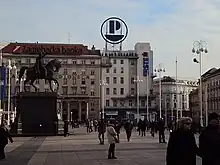Ignjat Fischer
Ignjat Nathan Fischer (18 June 1870, Zagreb – 19 January 1948, Zagreb) was a Croatian architect who was active in Zagreb during the first half of the 20th century.[1][2]
Ignjat Fischer | |
|---|---|
| Born | 18 June 1870 |
| Died | 19 January 1948 (aged 77) |
| Nationality | Croat |
| Occupation | Architect |
| Buildings | Parliament of Croatia |
Early life and education
Fischer was born in Zagreb to a Croatian-Jewish family.[2][3][4] His father Samuel was a prominent construction engineer.[2][5][6][7] Fischer studied in Vienna and Prague.[2]
Career

In his early stage he was one of the major architects who introduced the Vienna Secession in Croatian architecture. During that phase he created several impressive designs, such as a house Rado at Strossmayer Square 7 in 1897, sanatorium in Klaićeva Street known for its V-based ground plan in 1908, and the building of the deanery and the institute of pathology at the Medical Faculty of Šalata in 1912.[2][8]
During the Interwar period, Fischer designed in the spirit of late modernism, historicism and, modestism. His greatest achievements are the forestry Academy building in Mažuranić Square 5 in 1920, the head office of City Savings Bank of Zagreb on Ban Jelačić Square in 1922–1925 (upgraded in 1931), and modern house Arko at Dolac Market.[2][9]
The full extent of Fischer's work is not known with certainty. Recent research discovered a number of architectural designs that were previously not attributed to him, most notably the building of the Croatian Parliament in the St. Mark's Square.[2][6] In Zagreb, he had a large studio where he designed up to forty different buildings.[2]
Personal life
Fischer was a member of Croatian Freemasonry.[2][10] He was married to Helena (née Egersrodfer) with whom he had two daughters, Ivana and Marija Magdalena. Events before and during World War II affected his health.[2] His daughter Ivana recalled that her "father was imprisoned even when he was 70 years old, because he was a Jew. As a result of those persecutions he became seriously ill and died in 1948."[6] Fischer was buried at the Mirogoj Cemetery.[11][12]
See also
- Ivana Fišer (daughter)
References
- "Zagrebačka židovska topografija u Donjem gradu" (PDF). www.zoz.hr (in Croatian). Ha-Kol, magazine of the Jewish community Zagreb.
- Bagarić (2011)
- Goldstein (2005, p. 287)
- Snješka Knežević (2011, p. 177)
- "The Jews of Croatia". www.jewishrenaissance.org.uk. Jewish Renaissance. Archived from the original on 26 July 2010. Retrieved 9 December 2010.
- "Ignjat Fischer: Projektirao je i Hrvatski sabor, ali i javne kuće u Kožarskoj ulici". www.jutarnji.hr (in Croatian). Jutarnji list. Archived from the original on 12 January 2014. Retrieved 12 September 2011.
- (in Croatian) Ha-Kol (Glasilo Židovske zajednice u Hrvatskoj); Aleksander Laslo, Nataša Maksimović Subašić; Graditelji novog Zagreba; stranica 22; broj 108, siječanj / veljača 2009.
- Bagarić, Marina (2006). "Sanatorij u Klaićevoj ulici u Zagrebu - djelo arhitekta Ignjata Fischera" (PDF). Radovi Instituta Za Povijest Umjetnosti (in Croatian). Zagreb: Institute of Art History (30): 265–280. Retrieved 19 November 2018.
- Marina Biluš (16 October 2007). "19 dragulja u centru Zagreba" [19 gems in the centre of Zagreb]. Nacional (in Croatian). No. 622. Archived from the original on 23 May 2012. Retrieved 19 November 2018.
- "FOTO Novi broj magazina Svijet ekskluzivno donosi: Prvi pogled u londonski dom Gorana Štroka". www.jutarnji.hr (in Croatian). Jutarnji list.
- "Grobno mjesto Ignjata Fischera F-9-I-4" (in Croatian). www.gradskagroblja.hr. Retrieved 13 June 2012.
- (in Croatian) Gradska groblja Zagreb: Ignjat Fischer, Mirogoj RKT-9-I-4
Bibliography
- Goldstein, Ivo (2005). Židovi u Zagrebu 1918 – 1941. Zagreb: Novi Liber. ISBN 953-6045-23-0.
- Bagarić, Marina (2011). Arhitekt Ignjat Fischer. Zagreb: Meandarmedia. ISBN 978-953-735-576-0.
- Snješka Knežević, Aleksander Laslo (2011). Židovski Zagreb. Zagreb: AGM, Židovska općina Zagreb. ISBN 978-953-174-393-8.